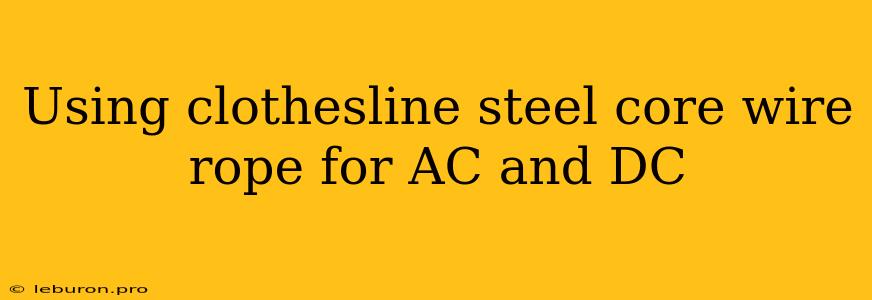Clothesline steel core wire rope, commonly known as "clothesline cable," is a versatile material used for various purposes, including the construction of AC and DC electrical transmission lines. Its strength, durability, and low cost make it an attractive option for many applications. This article delves into the specific properties and considerations when using clothesline steel core wire rope for AC and DC electrical transmission lines.
Understanding Clothesline Steel Core Wire Rope
Clothesline steel core wire rope consists of multiple strands of steel wire woven together around a central core. This core can be made of various materials, including steel, fiber, or even a combination of both. The core provides structural support and flexibility to the rope, while the individual wires contribute to its strength and load-bearing capacity.
Key Characteristics:
- Strength: Steel core wire rope is remarkably strong, capable of supporting significant weights and tensile forces. This strength is crucial for ensuring that the transmission line remains stable and secure, even under adverse weather conditions.
- Durability: The steel construction makes clothesline wire rope highly resistant to wear and tear, extending its lifespan and reducing maintenance requirements.
- Flexibility: The woven structure provides a degree of flexibility, allowing the rope to adapt to changes in terrain and wind conditions.
- Cost-effectiveness: Compared to other types of electrical conductors, clothesline wire rope is relatively inexpensive, making it a financially viable option for many projects.
Applications in AC and DC Transmission Lines
AC Transmission Lines
In AC (Alternating Current) transmission lines, clothesline steel core wire rope is often used as a supporting conductor for the primary power conductors. These supporting conductors are commonly called "ground wires" or "shield wires." Their role is crucial in protecting the primary conductors from lightning strikes and providing a path for fault currents.
Advantages of using clothesline steel core wire rope in AC transmission lines:
- Improved lightning protection: The wire rope acts as a Faraday cage, diverting lightning strikes away from the primary power lines, minimizing the risk of outages.
- Increased safety: The ground wire provides a low-resistance path for fault currents, mitigating the risk of electrical shock and ensuring the safety of personnel.
- Reduced electromagnetic interference: The wire rope helps to reduce electromagnetic interference caused by AC power lines, improving the overall performance and stability of the system.
DC Transmission Lines
In DC (Direct Current) transmission lines, clothesline steel core wire rope can be used for both supporting conductors and primary conductors depending on the voltage level and the overall design of the system.
Advantages of using clothesline steel core wire rope in DC transmission lines:
- Lower conductor sag: The strength of the wire rope minimizes sag, allowing for longer spans between support structures and reducing construction costs.
- Improved conductor stability: The wire rope's rigidity helps to maintain the stability of the DC conductors, even in high-wind conditions.
- Flexibility for complex terrain: The wire rope's flexibility allows for installation in challenging terrains, making it a practical choice for various project locations.
Considerations for Using Clothesline Steel Core Wire Rope
While clothesline steel core wire rope offers numerous benefits for AC and DC transmission lines, several factors must be considered before utilizing it for any specific application.
- Voltage Rating: The electrical insulation of the wire rope must be compatible with the voltage of the transmission line. In high-voltage applications, specialized insulation techniques may be necessary to prevent electrical breakdown.
- Environmental Conditions: The wire rope's corrosion resistance needs to be assessed for the specific environmental conditions it will encounter. In corrosive environments, additional protective coatings may be required to extend its lifespan.
- Mechanical Loads: The wire rope's strength and flexibility need to be evaluated based on the expected mechanical loads, including wind loads, ice accumulation, and other external forces.
- Installation Methods: The chosen installation method should be appropriate for the type and size of the wire rope and the design of the transmission line.
Conclusion
Clothesline steel core wire rope offers an advantageous and cost-effective solution for various applications in AC and DC electrical transmission lines. Its strength, durability, and flexibility make it a valuable asset for supporting conductors and even primary conductors in certain instances. However, careful consideration must be given to voltage rating, environmental conditions, mechanical loads, and installation methods to ensure safe and efficient utilization of this versatile material. By understanding the specific properties and considerations involved, engineers and project managers can leverage clothesline steel core wire rope's unique attributes to construct robust and reliable electrical transmission lines.
